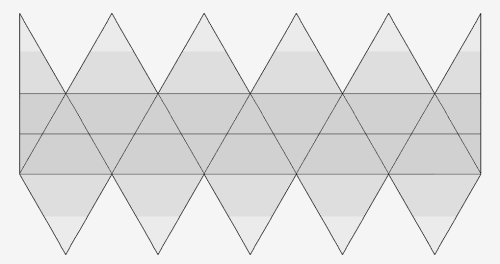Stellaris (world)
| Stellaris/Zarn (Canopus 2519) | |||||||||||||||||||||||||
| Classic Era (1116) | E200225-7
| ||||||||||||||||||||||||
| See also | UWP | ||||||||||||||||||||||||
| System Details | |||||||||||||||||||||||||
| Primary | M3 V | ||||||||||||||||||||||||
| Planetoid Belts | 0 | ||||||||||||||||||||||||
| Gas Giants | 2 | ||||||||||||||||||||||||
Stellaris is a low-population vacuum world, with a population of less than 10,000 sophonts, warranting hazardous environment precautions.
- Life in a vacuum requires great discipline. After all, it only takes one forgotten seal on a vacuum suit to spell death. Those who survive tend to be very methodically-minded and attentive to small detail.
- It is a member of the Solomani Confederation in the Zarn Subsector of Canopus Sector.
- This world is a "Twilight Zone World", a planet that is tidally-locked to its star. It has a hot side that permanently faces the star, a cold side that permanently faces away, and a narrow twilight zone in-between.
- It is a member of the Cassion Strand.
Description (Astrography & Planetology)[edit]
Stellar Data[edit]
Stellaris has a solitary primary star.
- It is a red main sequence.
System Data[edit]
The worlds of the system have been surveyed. They consist of:
- The mainworld.
- x8 secondary rocky worlds.
- x2 gas giants.
Mainworld Data[edit]
Stellaris is tidally locked to its primary star.
- The star is always high in the sky on the bright face, it hangs on horizon in the twilight zone, while the cold dark face is in permanent darkness.
- The world experiences libration - a regular wobble - as it orbits, causing the star to move in the sky.
Mainworld Size (S)[edit]
Stellaris is a Small World between 2,400km and 4,000km in diameter. The world has low gravity between 0.1G and 0.17G. The horizon will appear about 2.5km away.
Mainworld Atmosphere (A)[edit]
Stellaris has a pressure of less than 0.001 atmospheres which requires the use of a Vacc Suit. TL–8 or more advanced survival gear is required to settle this world.
Mainworld Hydrosphere (H)[edit]
Stellaris has no free-standing water or ice on the surface. Wilderness refueling isn't possible on this world. Water for the inhabitants needs to be imported and extensively recycled. These worlds are classified Desert World or a Hell World depending on their atmosphere.
Mainworld Geography and Topography[edit]
No centrally held map of the world exists within AAB Library Data records.
History & Background (Dossier)[edit]
Stellaris is a member of the Cassion Strand, a small cluster and minor trade route lying within the coreward-trailing quadrant of the sector, close to the border with Aldebaran Sector.
Solomani Security keeps a close eye on things to ensure the security of the Confederation and the well-being of its loyal citizens. Almost anyone could be a SolSec informant, passing on all sorts of useful information: some gain a reward or benefit for their actions, others are coerced, but many see it as an act of duty to help protect the Solomani state and its interests.
World Starport (St)[edit]
Stellaris has a Class E Starport, a frontier quality installation with few expected amenities. There is unrefined fuel for starships and a limited variety of ship provisions. There is no shipyard of any kind, but there may be parts and technical support for doing minor services and repair. Ports of this classification generally consist of a downport.
World Population (P)[edit]
Stellaris has population of 200 sophonts (hundreds).
- This is a Low Population World and the population would be too low to sustain itself without moderate outside assistance. This may represent a large transient population such as the crew of a fleet of starships, the dwindling remnants of a dying colony, a construction team building a new colony, or an outpost that could evolve into a colony.
- The population almost entirely consists of Solomani humans.
Linguistic Topography[edit]
The most commonly heard languages are:
- Rim Anglic, a dialect of Anglic and the principal language of the Confederation.
World Technology Level (T)[edit]
Stellaris possesses a Technology Level of TL–7.
- Common Communication technologies for this TL include: Early video and early satellite communication networks.
- Common Power Generation technologies for this TL include: Early fuel cells, solar energy, and geothermal power sources.
- Common Transportation technologies for this TL include:
- Land: Improved automobiles, hovercraft, and bullet trains.
- Water: Hydrofoils and early triphibians.
- Air: Hang gliders and supersonic jets.
- Space: Deep space probes and interplanetary spacecraft (System Craft).
World Government (G)[edit]
Stellaris is governed by a Participatory Democracy where eligible voters determine laws and policy. What determines an eligible voter varies. There may be smaller councils or regional bodies to draft the policies voted upon. Leadership of the government and all members of the bureaucracy are determined by the voting population.
World Law (L)[edit]
Stellaris has a moderate level with laws covering many areas of government and interaction. These laws are simple enough that most people can act as their own advocate, though for serious issues a professional is recommended. Law enforcement officials will be present, but not in great numbers. Personal concealable firearms, and anything more destructive, are typically regulated or prohibited.
Trade Data[edit]
- Importance: -3 (very unimportant)
World Economy[edit]
- Resources: B (abundant)
- Labor: 1 (tens)
- Infrastructure: 0 (non-existent)
- Efficiency: -1 (average)
World Culture[edit]
- Heterogenity: 2 (monolithic)
- Acceptance: 1 (extremely xenophobic)
- Strangeness: 6 (very distinct)
- Symbols: 8 (somewhat abstract)
World Timeline[edit]
Major events that have affected this world and the wider region that it lies within:
- -9235: far to coreward, the Vilani discover jump drive technology. Over the centuries pioneers and settlers gradually spread across Charted Space.
- -4045 to -2204: the Ziru Sirka controls vast territories.
- -2431: Terrans discover jump drive technology.
- -2404 to -2215: the Interstellar Wars.
- -2204 to -1776: the Rule of Man administers the former Ziru Sirka.
- -1862 to -1110: the Terran Mercantile Community is active across the region.
- -1776 to 0: the Long Night.
- -1110 to 588: the Terran Mercantile Community gradually becomes the Old Earth Union, shrinking to control the region around Terra.
- The Year 0: to coreward, the Third Imperium is founded.
- 300-420: the Imperial First Survey charts the system.
- 588: the Old Earth Union and the former territories of the Terran Mercantile Community are annexed by the Imperium.
- 604-622: the Imperial Civil War.
- 624: the Imperial Express Boat Network is established.
- 704: the Solomani Autonomous Region is formed.
- 800-820: the Psionics Suppressions.
- 871: the Solomani Confederation is founded.
- 940: the Solomani Autonomous Region is dissolved.
- 990-1002: the Solomani Rim War.
- 995-1065: the Imperial Second Survey includes data for the system.
- 1065: the Second Survey is published. Information about the system becomes widely available.
References & Contributors / Sources[edit]
| This article is missing content for one or more detailed sections. Additional details are required to complete the article. You can help the Traveller Wiki by expanding it. |
- John Harshman, Marc Miller, Loren Wiseman. Classic Traveller Supplement 8 Library Data (A-M), (Game Designers Workshop, 1981), various pages. (Library data entries)
- John Harshman, Marc Miller, Loren Wiseman. Classic Traveller Supplement 11 Library Data (N-Z), (Game Designers Workshop, 1982), various pages. (Library data entries)
- John Harshman, Marc Miller. Solomani (Game Designers Workshop, 1986), IFC, pages 3, 28. (sector named, background for the sector)
- Marc Miller. Imperial Encyclopedia (Game Designers Workshop, 1987), IFC. (Wars of the Imperium: sector named and shown)
- Peter G. Celella, James Holden. Solomani & Aslan (Digest Group Publications, 1991), pages 8-11, various others. (dot map locating the worlds of the sector, background for the sector)
- Michael Taylor. Fighting Ships of the Solomani (QuikLink Interactive, 2009), page 5. (background for the sector)
- David L. Pulver. Solomani (Mongoose Publishing, 2012), pages 50, 118, 119, various others. (background for the sector)
- Zho Berka's Maps (Classic Era UWP Data for the world)
- CORE Data Site (UWP Data for the world)
- Author & Contributor: Rupert Boleyn (data generated to match dot map)
- Author & Contributor: Garnfellow (development of the sector)
- ↑ "Jump Map API" and map location from Travellermap.com




